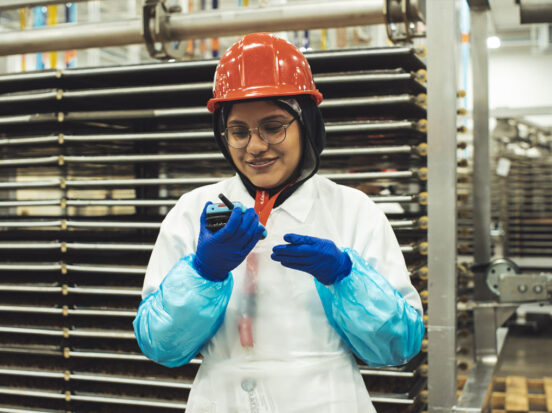Miscommunication on the factory floor leads to costly delays, safety risks, and wasted effort — problems no manufacturer can afford. When departments operate in silos or updates do not reach the right people, the entire operation suffers.
Communication in manufacturing goes beyond simply exchanging information — it lays the foundation for safety, quality control, and productivity. With teams often spread across shifts, departments, and sites, clear and timely communication is critical to efficient operations and worker engagement.
In this guide, you will learn 10 proven steps to improve manufacturing communications, so you can reduce downtime, avoid errors, and create a safer, more productive workforce.
- Miscommunication on the production floor creates delays, safety risks, and lost productivity — but it can be fixed with the right systems.
- Leaders and frontline teams communicate best when updates are clear, immediate, and accessible to every worker across shifts.
- A unified manufacturing plant communication system reduces downtime by cutting through noise, language barriers, and scattered channels.
- The Walt Smart Radio System by weavix® delivers manufacturing teams seamless, secure communication — keeping every worker connected and informed wherever they are.
Why Seamless Manufacturing Communication Is Critical to Long-Term Success
Communication in manufacturing is essential because it drives operational efficiency, product quality, and employee engagement. When all departments — from design to logistics — are aligned, organizations minimize errors and maximize productivity. A robust manufacturing communication system reduces downtime, accelerates decision-making, and ensures adherence to quality standards.
Quality control also relies on seamless manufacturing communication. Clear and documented channels help operators identify, report, and resolve defects before products reach customers. This safeguards a manufacturer’s reputation and supports customer satisfaction.
Safety and compliance are also strengthened by open communication. Real-time messaging and immediate access to updated procedures greatly reduce the risk of workplace incidents. According to Microsoft’s Work Trend Index Special Report, 63% of workers say they do not receive messages from leadership, leading to preventable mistakes and safety lapses.
Prioritizing strong communication solutions also increases employee satisfaction and retention. When frontline workers feel informed and recognized, they invest more in their roles, resulting in a more effective and adaptable operation.
How Do Communication Gaps Impact Manufacturing Operations?
Communication problems in manufacturing create avoidable inefficiencies and risks. Without robust manufacturing communication systems, critical updates are missed, workers operate on outdated information, and overall performance falls short.
Communication gaps lead to:
- Production delays and increased downtime: Gaps in communication about schedules, materials, or maintenance cause costly bottlenecks. If one team is not informed of a component shortage, an entire production line can grind to a halt.
- Quality control failures: When changes in standards or processes are not clearly communicated, operators may unknowingly continue old procedures, resulting in higher rates of rework and waste.
- Safety incidents: Incomplete dissemination of safety protocols increases the risk of workplace accidents.
- Low employee morale and retention: Disconnected workers are less engaged and more likely to leave. According to Gallup, highly engaged business units experience 78% less absenteeism and 14% higher productivity.
Keep reading: Discover how Walt by weavix solves classic workplace communication barriers
What Are the Benefits of Effective Communication in Manufacturing?
The benefits of effective communication in manufacturing include greater productivity, improved quality, and increased worker satisfaction. Clear information, delivered quickly and in the right format, transforms operational outcomes, providing:
- Increased productivity: Defined work instructions and open feedback loops enable faster problem-solving, proper prioritization, and less wasted effort.
- Heightened safety: Real-time safety alerts, regular training updates, and clear language minimize confusion and reduce incident rates.
- Improved quality control: Employees who can quickly report issues and verify requirements help prevent defects from reaching customers.
- Stronger employee engagement: Informed workers are more invested in process improvement, teamwork, and the company’s success, so retention rates improve.
- More agile supply chains: Fast, accurate communication between teams means changes in demand or disruptions are handled quickly, keeping production on schedule.
Keep reading: 10 reasons every worker needs an industrial radio

How Manufacturing Communication Systems Change Operational Workflows
Manufacturing communication systems streamline critical operations and empower employees to act on accurate, up-to-date information. They benefit manufacturers through:
- Real-time data sharing: Connected devices transmit equipment statuses, quality alerts, and safety updates instantly, so nothing is missed.
- Enhanced collaboration: Digital communication platforms provide frontline workers with access to instructions, troubleshooting guides, and escalation paths.
- Predictive maintenance: Monitoring tools automatically alert engineering and maintenance staff to issues, allowing for intervention before breakdowns occur.
- Standardized shift handovers: Digital shift logs and checklists ensure that information seamlessly passes between teams, reducing costly miscommunications.
Keep reading: A guide to frontline workforce collaboration in 2025
10 Steps to Foster Effective Communication in the Manufacturing Industry
For plant managers and supervisors, effective communication means workers get the right updates at the right time so production doesn’t slow and no one is left without critical information. The following steps will help any manufacturer address gaps and build a robust culture of communication across shifts, teams, and locations.
1. Evaluate Current Communication Skills in Manufacturing
Start by assessing how well updates move across shifts, teams, and supervisors. Reviewing incidents, handovers, and daily logs highlights gaps in communication skills in manufacturing and shows where mistakes or delays most often happen. That baseline helps you decide what needs to change. Use these insights to create clear improvement priorities.
2. Facilitate Interaction Between Leadership and Frontline Teams
Regular “Gemba” walks — where leaders go to the production floor — and quick huddles help supervisors understand real floor challenges. Workers get a chance to raise issues directly, and managers can make faster, better-informed decisions.
3. Encourage Verbal, Written, and Visual Communication
Blend written instructions, quick-reference visuals, and verbal briefings so every worker understands priorities and procedures completely. For example, use:
- Quick visual boards for priorities
- Written notes for procedures
- Short verbal check-ins for immediate needs
That mix ensures nothing gets overlooked.
4. Use a Unified Manufacturing Plant Communication System
Relying on different devices leads to delays and missed updates. A unified manufacturing plant communication system brings everything into one platform, so alerts, instructions, and direct messages reach the right people without confusion.
5. Provide Noise-Canceling Earbuds for Work Areas
On a loud floor, instructions can be missed. Equip workers with PPE-compatible earbuds to ensure they hear critical updates without stepping out of their environment or compromising safety.
6. Implement Communication Tools for Safety Updates
When equipment fails, conditions change, or emergencies happen, workers need alerts instantly. Use mobile apps or mass notifications to deliver urgent safety messages directly to all staff.
7. Ensure Multilingual Accessibility
Support your diverse workforce with AI language translation and training materials in all spoken languages so everyone understands safety protocols, procedures, and updates in real time. This process improves safety drills, speeds up onboarding, and reduces rework caused by miscommunication.
8. Promote Real-Time Feedback and Collaboration
Workers should be able to report issues the moment they see them, whether that’s a machine running outside spec, a missing material, or a safety concern. Allow your frontline to escalate issues, share solutions, and flag hazards instantly using connected worker app technology.
9. Offer Support and Training for Workers
Invest in ongoing training on communication best practices, new tools, and effective team problem-solving. For example, supervisors can run short toolbox talks, while HR and safety teams can provide quick reference guides and coaching.
10. Gather Data Insights to Improve Your Communication Strategy
Continuously measure the adoption and impact of new communication processes. Adjust and refine strategies using worker surveys and operational data, such as:
- Response times to safety alerts and shift updates
- Acknowledgment rates showing which workers received and confirmed instructions
- Message delivery by shift or department to identify blind spots
- Training completion and system usage data to track adoption
- Downtime avoided by acting on real-time communication

Keep Your Workforce Moving With the Best Production Floor Communication Platform
The Walt Smart Radio System by weavix® elevates communication in manufacturing with real-time connectivity, clarity, and resilience for every production setting. Built specifically for the challenges of the plant floor, Walt delivers reliable, secure communication that keeps your entire team informed, reduces costly downtime, and strengthens operational excellence.
Walt is more than a radio — it is a unified production floor communication and safety platform designed for today’s manufacturing needs. With seamless voice communication across roles and shifts, rugged waterproof construction, and frontline workforce software integration, Walt bridges every gap. Over-the-air updates keep devices secure and equipped with the latest features, eliminating outdated manual rollouts.
Transform operational workflows and empower your workforce with a smart radio platform purpose-built for manufacturing. To see how Walt can help you future-proof your business, contact us.
Frequently Asked Questions
What is communication in manufacturing?
Communication in manufacturing is the systematic exchange of information among people, equipment, and digital systems throughout the plant. Effective communication means that every worker, manager, and machine is connected — enabling collaboration, quick updates, and clear instructions.
With the right tools, manufacturers minimize errors, reduce downtime, and optimize production at every level.
Which tools does weavix provide to improve production communication?
weavix offers solutions that unify real-time messaging, task management, safety notifications, and multimedia messaging service in a single, intuitive platform.
With features like instant translation, hands-free operation, and integrated workforce management, the Walt Smart Radio System helps manufacturers solve the challenge of how to improve communication in manufacturing, reducing errors and increasing safety across all roles and locations.


